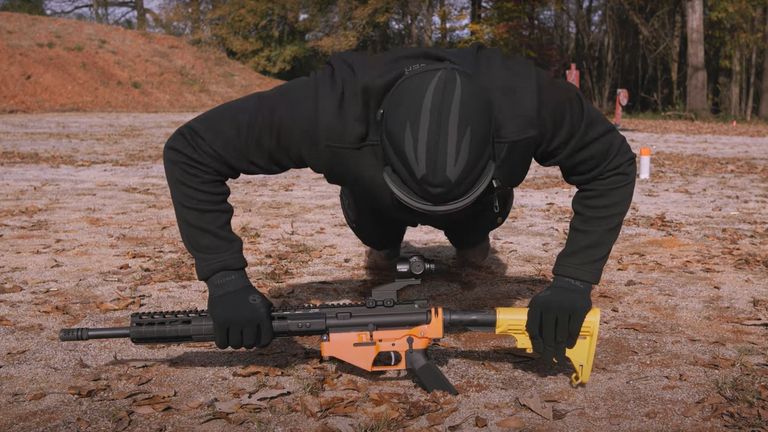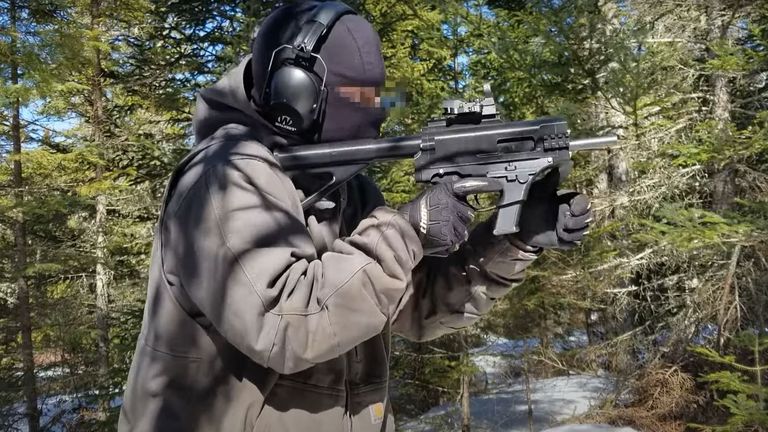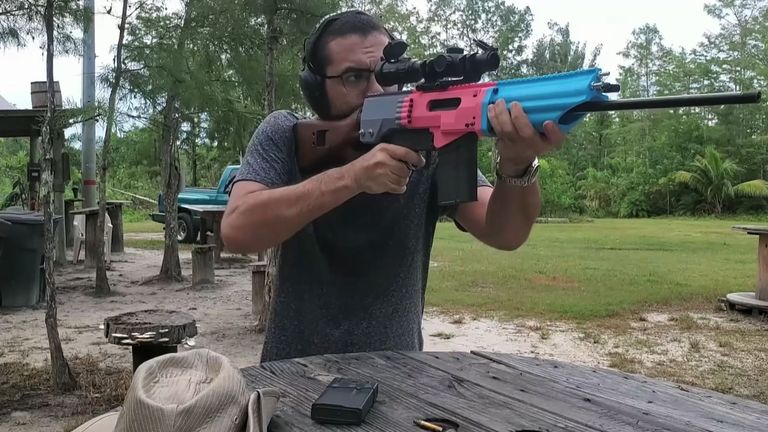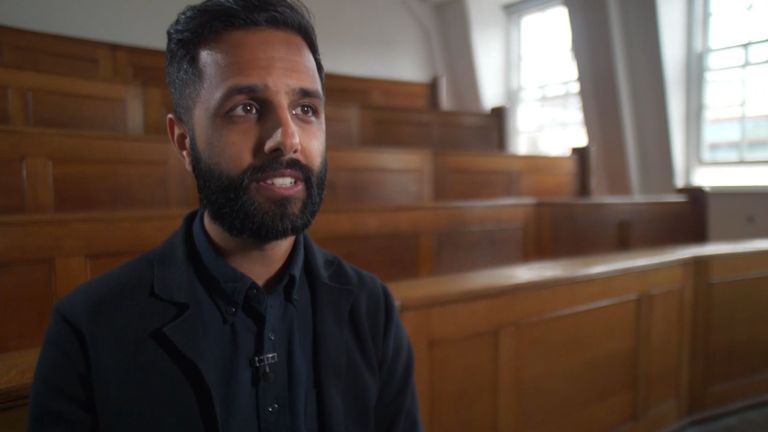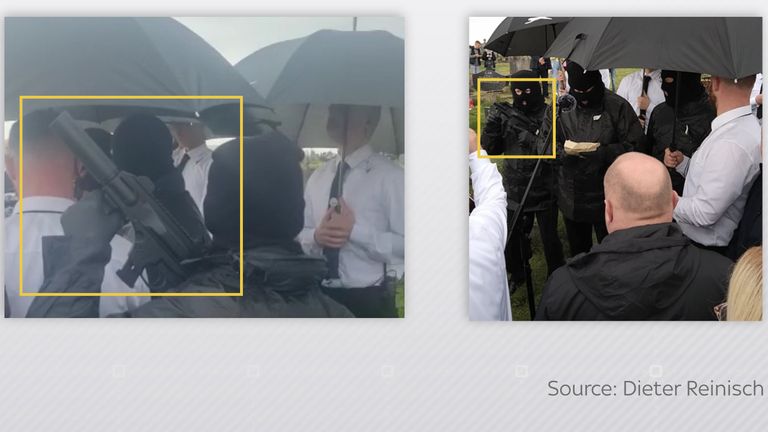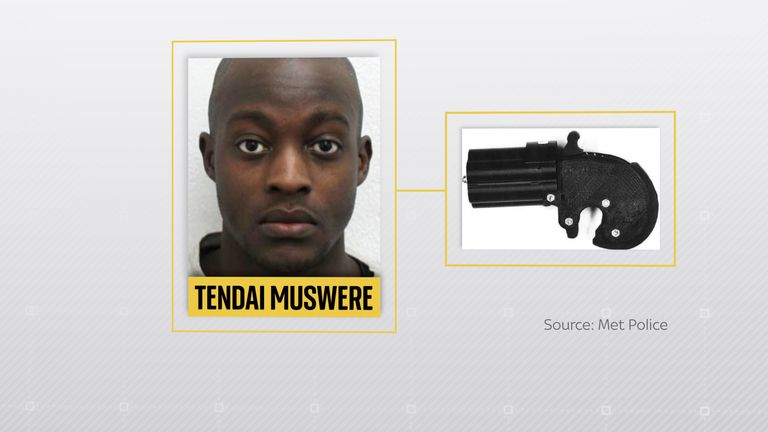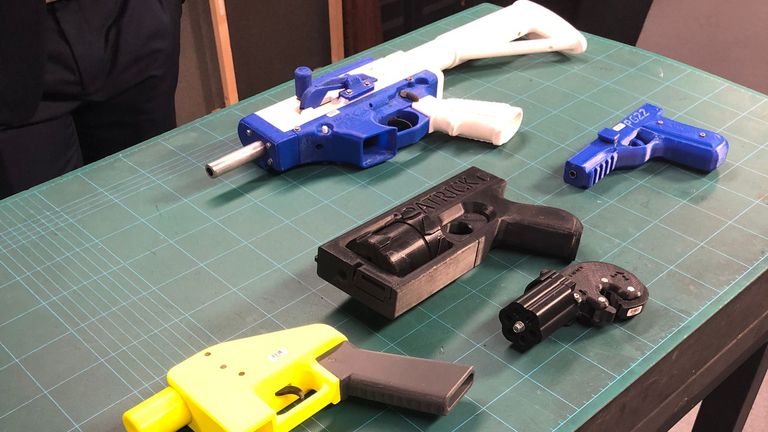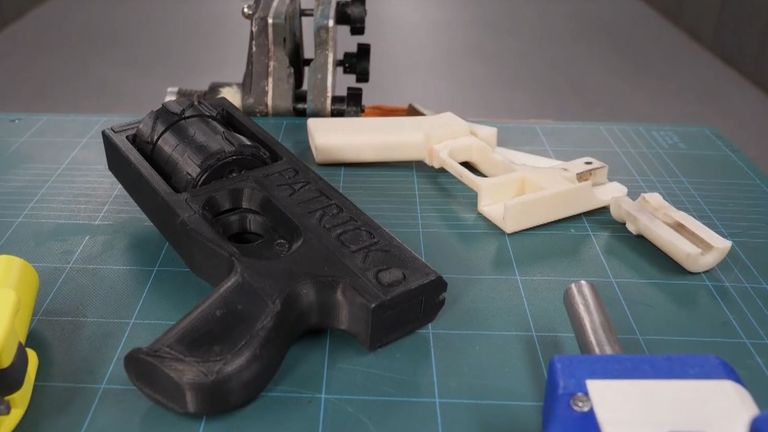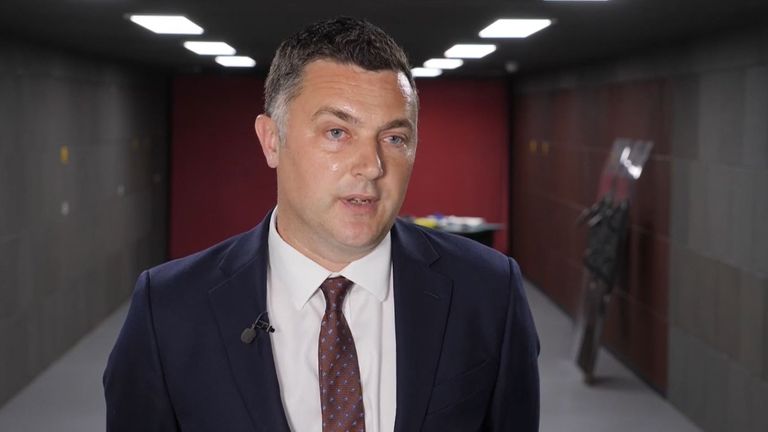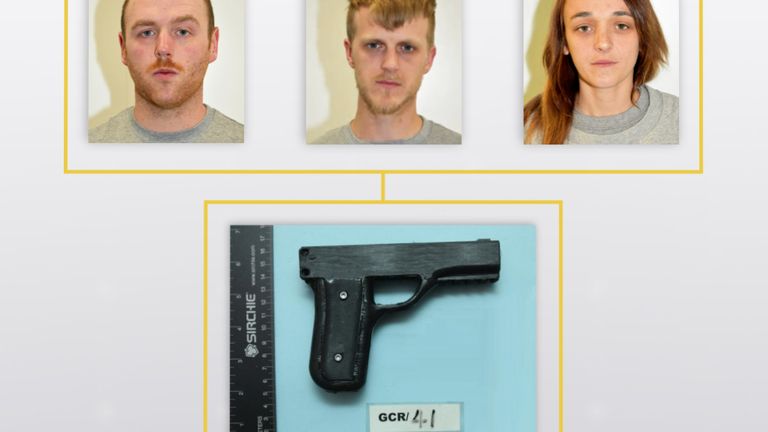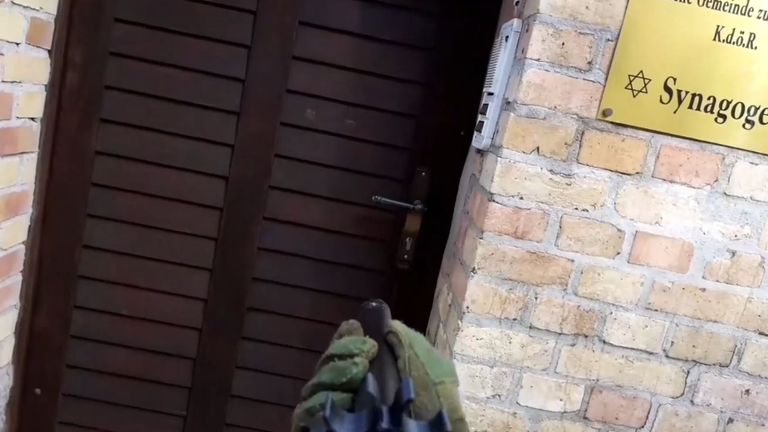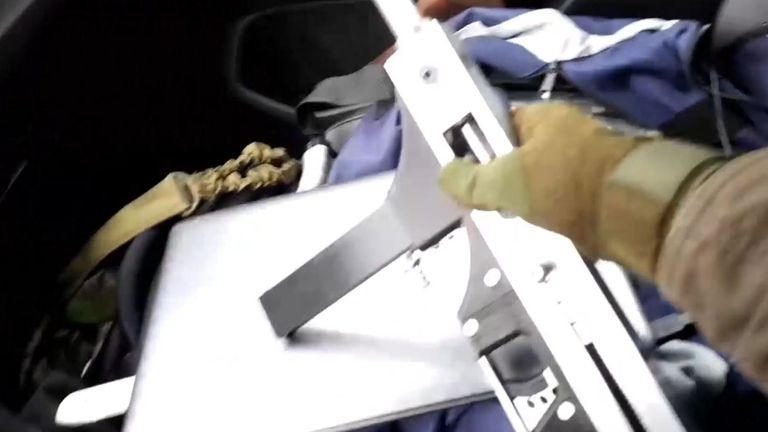[ad_1]
The files needed to print a gun are not buried on the dark web.
They can be downloaded in as little as three clicks from mainstream social media sites such as YouTube.
3D-printed gun technology has rapidly advanced in recent years – with a range of printable semi-automatic rifles, carbines and pistols available.
Those who create and share the designs for these firearms have thousands of followers on Twitter, YouTube and Instagram.
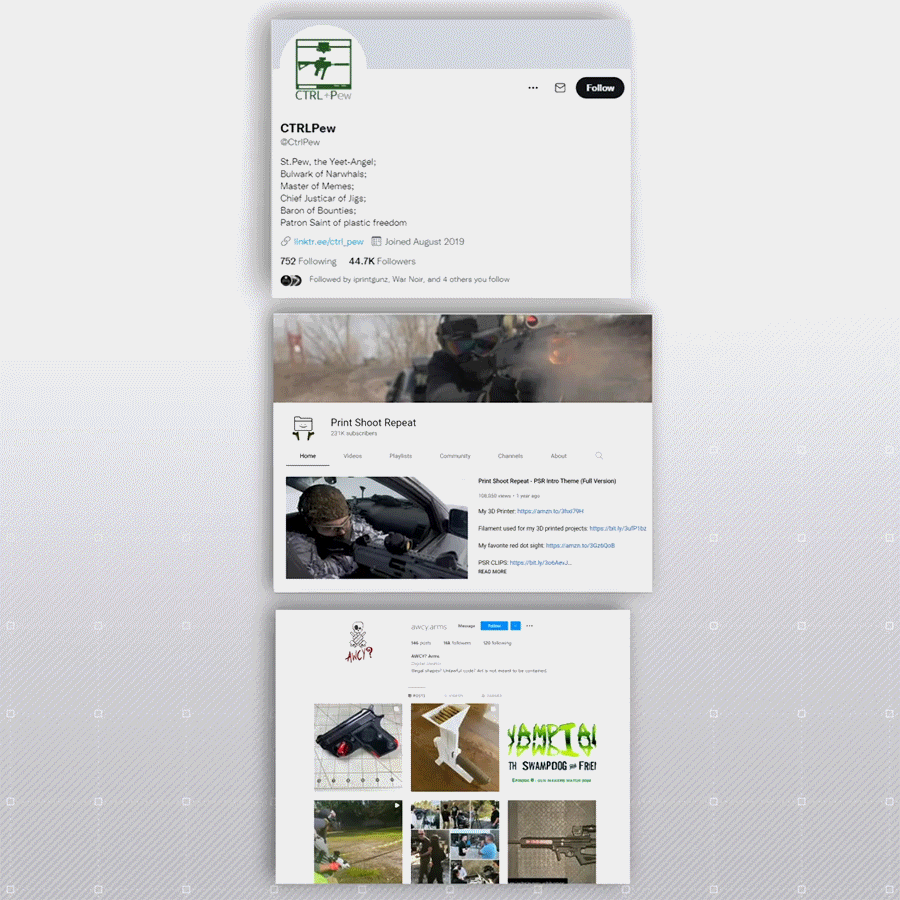
Although popular in the US, where they are legal, 3D-printed guns are beginning to appear more frequently in the UK.
The Metropolitan Police have told Sky News in an exclusive interview that they have recovered four 3D-printed guns since 2018. They are treating printed firearms as an “emerging trend” that the force are actively monitoring.
‘F*** Gun Control 9’
A community of mostly American and mostly male 3D-printed gun enthusiasts has sprung up online.
These hobbyists make designs, distribute them for free and film themselves testing the weapons – including doing push-ups on top of the guns to show how sturdy they are.
They use their social profiles to help direct people to find the downloadable files, as well as the accompanying assembly manuals and equipment lists.
Here’s how they do it:
Matt Larosiere is part of that online community. He says there is no centralised group behind the movement but what unifies them is a desire to protect their freedoms and enable others to do so too.
He told Sky News: “There’s no 3D Guns Incorporated. There’s no CEO of 3D-printed guns.
“But I will tell you the prevailing motivations that I’ve seen of the people in our communities is just an incredible love of freedom and the people and an understanding that we have the right to bodily autonomy.
“And the best way to keep our bodies secure is to have effective mechanisms to defend ourselves.”
Mr Larosiere believes governments are part of the threat individuals face. He argues there is the potential for governments to endanger a person or infringe on the public’s freedom.
“Frankly, as we’ve seen in places like Myanmar, the government is generally lying to you about most things and you should probably print a gun in case you have to shoot them,” he explains.
How easy is it to make a 3D-printed gun?
3D-printed guns are often talked about as cheaper and easier to obtain than other firearms, but it’s not that clear cut.
Rajan Basra is a senior research fellow at the International Centre for the Study of Radicalisation at King’s College London. He has been closely following the advent of 3D-printed guns.
“It’s a very simplified view to say that with a couple of hundred pounds you could 3D print a gun,” Dr Basra explains.
“There are many obstacles when it comes to getting a working gun in your hand and each step in that manufacturing process represents another point of intervention for the authorities.
“It’s another point where you could be caught.”
One potential obstacle is the cost of purchasing a 3D printer, which builds up layers of filament into viable firearm components based on the design files, seen in the animation below.
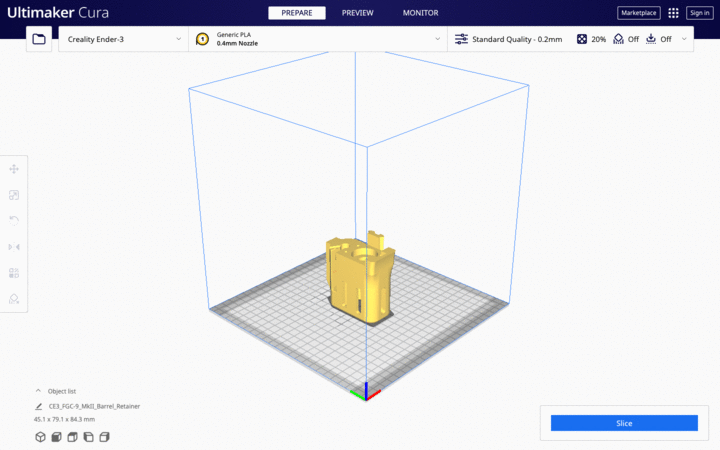
These printers have become more affordable in recent years but cost at least £150.
There is also a misconception that 3D-printed guns can be made entirely behind closed doors because they are solely formed from plastic, which is not always the case.
An ’emerging trend’ in the UK
Mass shootings like the school attack in Uvalde, Texas have reignited debate in the US over the ease of access to firearms. This includes access to 3D-printed guns, which are not believed to have been used in such attacks.
America’s gun laws are relaxed in comparison with most of Europe, where firearms, including printable ones, are illegal.
The UK’s laws are some of the most robust and punitive. Despite this, 3D-printed guns are turning up.
Police in Northern Ireland are investigating two printed guns seen in the hands of Republican splinter group, Óglaigh na hÉireann.
And since 2019, six people in the UK have been prosecuted where 3D-printed guns played a role in their case.
For the first time, the Metropolitan Police agreed to show the public examples of the 3D-printed guns their team made to aide their research and a recovered FGC 9.
Matthew Webb, Detective Inspector for specialist crime in the Metropolitan Police, explained the FGC 9 was recovered in September 2021 in a borough in northeast London.
“Police were called by a member of the public to what they believed to be a firearm contained in a rucksack,” Det Insp Webb said.
“It’s certainly a technology that is developing and that is why we see it as an emerging threat.
“Technology has developed so you’re now talking hybrid weapons, metal and plastic together, allowing for somebody with knowledge and expertise in the area to be able to print a semi-automatic carbine style weapon as we see with the FGC 9.”
He adds that early designs were prone to breaking from the force of firing ammunition, unlike the more robust designs in recent years.
Even with the advancing technologies, 3D-printed guns make up only a fraction of the Met Police’s work currently, with the force seizing more than 500 traditional firearms last year alone.
But part of the challenge of policing 3D-printed guns is that they can be built discreetly. The Metropolitan Police say they are adapting.
Detective Chief Superintendent Nick Blackburn says his colleagues are being trained to look out for guns that do not look like conventional firearms. For example, officers will know to spot brightly coloured guns or those that may look like a toy.
He says: “It’s an emerging trend and one that our staff are aware of.
“We need to understand the threat, treat it as an emerging threat, monitor it, monitor those people that are looking at this online if we can and intercept those weapons before they hit the streets of London.”
Who is making Britain’s 3D-printed guns?
It’s unlikely that the greatest risk of an attack would come from the 3D-printed gun movement carrying out ideologically or politically motivated violence, according to Dr Basra’s research at the International Centre for the Study of Radicalisation.
Instead, he suggests there is a burgeoning link between these guns and extremists.
He said: “The reality is there are effective designs being posted on the internet. We’ve seen extremists share these designs [and] we’ve seen extremists who tried to construct 3D-printed guns.”
Dr Basra says members of the far right often share instructional documents and plans online in preparation for a so-called race war, increasing their chance of coming across gun files.
Examples of this can be seen in the UK, with five of the six people prosecuted in connection with 3D-printed guns having links to the far right. They all used online spaces to research, prepare for or begin to build a 3D-printed gun.
One case saw an undercover police officer intercept online plans between Daniel Wright, Liam Hall and Stacey Salmon from Yorkshire. A partially constructed 3D-printed firearm was recovered following their arrests.
Those convicted in England were stopped before they managed to cause physical harm.
But in Germany, a neo-Nazi equipped with 3D-printed guns and other improvised weapons killed two people and attacked a synagogue in 2019.
Stephan Balliet’s manifesto showed he hoped to prove the power of these homemade firearms but they repeatedly jammed.
Dr Basra does not think a terrorist incident with a 3D-printed gun is inevitable, but warns if it does happen it may inspire copycats.
He says: “It’s not when exactly that attack will take place. This technology does exist, it may take place in the next year or the next 10 years.
“The key point is will it inspire other people to follow that same attack with it, as we’ve seen with other attack methods, like vehicle ramming, stabbings, and so on?”
‘Celebrated and not vilified’
Social media companies whose platforms are being used to help direct people to these firearm files are actively trying to shut down accounts they deem to have violated platform policies on firearms.
Instagram and YouTube have removed accounts that broke their policies, which forbid content intended to instruct users on how to construct 3D-printed guns.
A Twitter spokesperson told Sky News: “Keeping people safe on Twitter is a top priority for us and it is against our rules to use our service for any illegal activities. This includes the selling, buying, or facilitating transactions in illegal goods or services, as well as certain types of regulated goods or services.
“We remain vigilant and take robust enforcement action where we identify violations of our rules. The accounts shared have been permanently suspended for violating the Twitter rules on Illegal or Regulated Goods or Services.”
As for those who design and make the gun files available, they distance themselves from those like Balliet.
Mr Larosiere explains: “Our only interest is the freedom of human beings to protect themselves.
“And frankly, in our groups, we have rules where the hateful content like that hateful speech, disparagement of others, especially based on race is not tolerated.”
The gun enthusiast disagreed with social media companies removing some of his community’s profiles, saying: “They’re just sharing their work and promoting the cause of human autonomy.
“I think it should be celebrated and not vilified.”
Credits
Reporter: Sanya Burgess
Graphics: Brian Gillingham, Charlie Parish, Bria Anderson, Yetunde Adeleye, Phoebe Rowe
Production: Lynn Morrish, Nasir Hassan
The Data and Forensics team is a multi-skilled unit dedicated to providing transparent journalism from Sky News. We gather, analyse and visualise data to tell data-driven stories. We combine traditional reporting skills with advanced analysis of satellite images, social media and other open source information. Through multimedia storytelling we aim to better explain the world while also showing how our journalism is done.
Why data journalism matters to Sky News
[ad_2]


